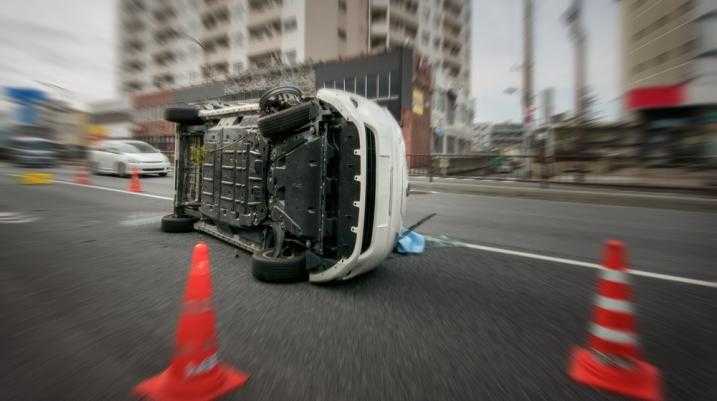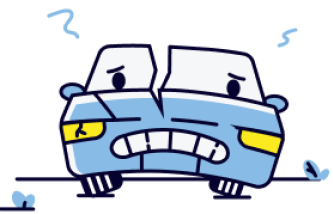What Are the Odds of Surviving a Rollover Car Accident?

The chances of surviving a car rollover accident are approximately 35%. Rollover car accidents are among the most severe and deadly types of vehicle crashes. These accidents often lead to catastrophic injuries, long-term disabilities, and even fatalities.
The jerking sensation of your car beginning to flip can happen unexpectedly in an instant—but can change a driver’s life forever. That’s why it’s so important to know the factors that influence survival rates, the injuries that commonly occur, and the legal options available to victims.
Taking the right precautions on the road could mean the difference between life or death, and taking the right steps after an accident could make the difference on how you can move forward with your life.
Below, we dive deeper into the factors that determine the dangers of a rollover car accident and what to do after you survive. If someone else’s negligence caused your serious car accident, then you may be entitled to compensation to help get your life back on track. Insurance companies often try to minimize payouts and offer inadequate means to get your life back on track. With Morgan & Morgan, America's largest personal injury law firm, you can fight for what you need and deserve.
Hiring one of our lawyers is easy, and you can get started in minutes with a free case evaluation.
What is a Rollover Accident?
A rollover accident occurs when a vehicle flips onto its side or roof during a crash. These accidents can be classified into two main categories:
- Tripped Rollovers: Occur when a vehicle’s tires hit an object (such as a curb or soft shoulder), causing it to flip.
- Untripped Rollovers: Result from high-speed maneuvers, such as swerving or taking sharp turns, without external forces triggering the rollover.
How Common Are Rollover Accidents?
While rollover accidents account for only a small percentage of total crashes (approximately 2.1% of all car accidents), they disproportionately result in a high number of fatalities. According to the National Highway Traffic Safety Administration (NHTSA), rollovers account for nearly 35% of all passenger vehicle fatalities.
Factors That Affect the Odds of Surviving a Rollover Accident
Several factors determine the likelihood of surviving a rollover accident, including vehicle type, speed, seat belt use, and the presence of safety features.
Vehicle Type and Design
- SUVs and Pickup Trucks: These vehicles are more prone to rollovers due to their high center of gravity.
- Sedans and Sports Cars: Generally have a lower center of gravity, making them less likely to roll over but not immune.
- Safety Ratings: Some vehicles are designed with reinforced roofs, rollover airbags, and stability control, improving survival odds.
Speed at the Time of the Accident
Speed is a significant factor in the severity of a rollover accident. Studies show that over 40% of fatal rollovers involve excessive speeding. The faster the vehicle is moving, the higher the impact force upon rolling over, which increases the likelihood of severe injury or death.
Seat Belt Usage
Seat belts are the single most effective safety measure in a rollover accident. The NHTSA reports that 75% of people ejected from a vehicle in a rollover crash do not survive. Wearing a seat belt reduces the risk of ejection and significantly increases the chances of survival.
Number of Rollovers
The number of times a vehicle rolls impacts survivability. A single rollover may result in minor injuries, whereas multiple rollovers dramatically increase the risk of serious harm due to repeated impacts.
Roof Strength and Vehicle Safety Features
A strong roof is critical in protecting occupants. Vehicles with weak roofs are more likely to cave in, causing severe head and spinal injuries. Modern safety features such as electronic stability control (ESC) and side-curtain airbags can further enhance survival odds.
Occupant Position and Restraint Systems
Passengers sitting in the front are more likely to survive compared to those in the back if they are not restrained properly. Additionally, child safety seats significantly improve survival odds for younger passengers.
Common Injuries in Rollover Accidents
Survivors of rollover accidents often suffer from severe injuries that require extensive medical treatment and rehabilitation.
Traumatic Brain Injuries (TBI)
Head trauma is common in rollovers, particularly when passengers hit the roof or side panels of the vehicle.
Spinal Cord Injuries
Rollover crashes frequently result in spinal injuries, leading to paralysis or long-term mobility issues.
Broken Bones and Fractures
The force of a rollover can cause broken ribs, arms, legs, and collarbones due to impact with the vehicle’s interior or ejection from the car.
Internal Injuries
Blunt force trauma can damage internal organs, leading to life-threatening complications such as internal bleeding.
Cuts and Lacerations
Glass shattering during a rollover can cause deep cuts and injuries that require stitches or reconstructive surgery.
How to Improve Your Odds of Surviving a Rollover Accident
While rollovers can be deadly, taking precautionary measures can significantly improve survival chances.
1. Always Wear a Seat Belt
Wearing a seat belt reduces the risk of fatal injury by up to 60% in rollover accidents.
2. Choose a Safe Vehicle
Select a vehicle with high safety ratings, reinforced roofs, and electronic stability control.
3. Drive at Safe Speeds
Avoid speeding, especially on curves, ramps, or wet roads, where rollovers are more likely.
4. Avoid Overloading Your Vehicle
Excess weight, particularly on the roof, raises the vehicle’s center of gravity, increasing the risk of a rollover.
5. Stay Alert and Avoid Distracted Driving
Drowsy or distracted driving increases the chances of sudden swerving, leading to loss of control.
What Should I Do After a Rollover Car Accident?
If you’ve been in a rollover car accident, taking the right steps can protect your health, safety, and legal rights. Here’s what you should do:
1. Check Yourself & Passengers for Injuries
If you’re able, check for injuries. If others are in the car, ensure they’re conscious and responsive.
Don’t move unnecessarily. If you suspect a neck or spinal injury, wait for emergency responders.
2. Get to Safety (If Possible)
If your vehicle is in traffic or at risk of fire, try to exit safely. If trapped inside, call 911 and stay calm while waiting for help. If you’re hanging upside down, brace yourself and carefully release your seatbelt while supporting your weight.
3. Call 911 Immediately
Report the accident and request medical assistance. Even if you feel fine, get checked by paramedics—some injuries aren’t immediately apparent.
4. Document the Scene
Take photos of your car, the accident site, and any visible injuries. Get witness statements and contact details. Next, record important details, such as time, location, road conditions, and how the accident happened.
5. Get Medical Attention
Even if you feel okay, see a doctor. Internal injuries, concussions, or whiplash may not show symptoms right away. Keep records of all medical evaluations and treatments.
6. Contact Your Insurance Company
Report the accident but avoid admitting fault until all facts are clear. Provide the police report and any necessary documentation.
7. Contact Morgan & Morgan
If you were injured due to another driver’s negligence, a vehicle defect, or unsafe road conditions, you may be entitled to compensation for medical bills, lost wages, and pain & suffering.
A personal injury attorney at Morgan & Morgan can help you navigate insurance claims and legal action.
Legal Options for Rollover Accident Victims
Victims of rollover accidents have options—and may be entitled to compensation for their injuries, lost wages, and medical expenses. Here’s how a Morgan & Morgan attorney can help:
Determining Liability
Potential liable parties may include:
- Negligent drivers
- Vehicle manufacturers (in cases of defective design)
- Government entities (if poor road conditions contributed to the accident)
Filing a Personal Injury Claim
If another party’s negligence caused the accident, victims can file a personal injury claim to recover damages for medical bills, lost wages, and pain and suffering.
Pursuing a Product Liability Case
If a vehicle’s design flaws contributed to the rollover, a product liability lawsuit against the manufacturer may be an option.
Seeking Compensation for Wrongful Death
Families of individuals who died in a rollover crash may be eligible for compensation through a wrongful death lawsuit.
Contact Morgan & Morgan Today
Surviving a rollover accident depends on several factors, including seat belt use, vehicle design, speed, and road conditions. While these accidents can be devastating, victims have legal options to pursue compensation for their injuries and losses.
If you or a loved one has been involved in a rollover accident, Morgan & Morgan is here to help. Our experienced attorneys can guide you through the legal process and fight for the compensation you deserve. Contact us today for a free case evaluation.
Injured? Getting the compensation you deserve starts here.

Injured?
Not sure what to do next?
We'll guide you through everything you need to know.